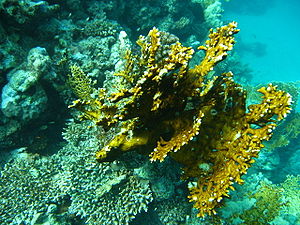Capitata
| Capitata | ||||||||||||
|---|---|---|---|---|---|---|---|---|---|---|---|---|

Fire coral ( Millepora sp. ) In the Red Sea near Port Ghalib |
||||||||||||
| Systematics | ||||||||||||
|
||||||||||||
| Scientific name | ||||||||||||
| Capitata | ||||||||||||
| Kühn , 1913 |
The Capitata are a very diverse group of hydrozoans from the order of the Anthomedusae . The best-known groups of the Capitata are the freshwater polyps ( Hydra ), which also occur in Europe, as well as the reef-forming fire corals from the tropical Indo-Pacific , the Red Sea and the Caribbean .
features
In both the polyps and the medusa phase, all capitata have special stinging cells , the complex stenotles (puncture capsules) that have a stylet made up of three thorns. They also contain highly effective nettle poisons that the animals can use to paralyze or kill their victims. This form of the nettle cells is otherwise only found in some Trachymedusae , the state jellyfish (Siphonophorae) and the Actinulidae . All anthomedusae that have stenotles belong to the capitata. If these are absent, they belong to the subordination Filifera .
Name-giving feature of the Capitata are the tentacles with a spherical "head" that the animals always have or only when they are young. However, there are also groups of Filifera, e.g. B. the Ptilocodiidae , which have capitate tentacles.
Familys
- Subordination Capitata
- Acaulidae family
- Family Asyncorynidae
- Family Boeromedusidae
- Family Boreohydridae
- Family Candelabridae
- Family Cladocorynidae
- Family Cladonematidae
- Family Corymorphidae
- Family Corynidae
- Family Halimedusidae
- Family Hydridae
- Family Hydrocorynidae
- Family Margelopsidae
- Fire coral family (Milleporidae)
- Family Moerisiidae
- Family Paracorynidae
- Family Pennariidae
- Family Porpitidae
- Family Protohydridae
- Family Pseudosolanderiidae
- Family Rosalindidae
- Family Solanderiidae
- Family Sphaerocorynidae
- Family Teissieridae
- Family Tubulariidae
- Family Tricyclusidae
- Family Zancleidae
- Family Zancleopsidae
- Capitata incertae sedis
literature
- Gruner, H.-E., Hannemann, H.-J., Hartwich, G., Kilias, R .: Urania Tierreich, Invertebrates 1 (Protozoa to Echiurida) . Urania-Verlag, ISBN 3-332-00501-4


